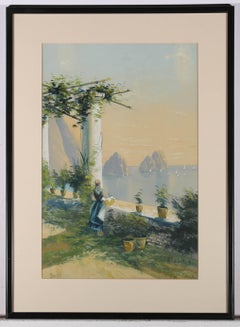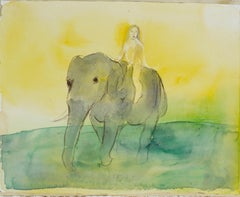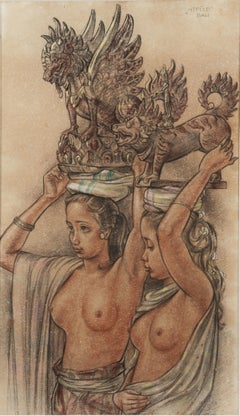Gianni Drawings and Watercolor Paintings
to
2
2
1
1
1
1
Overall Height
to
Overall Width
to
1
1
1
2
3
707
412
288
228
2
2
2
Artist: Gianni
Gianni - Early 20th Century Gouache, Mediterranean Coastal Town
By Gianni
Located in Corsham, GB
A charming gouache scene depicting a mother and child walking a walled terrace. The views looks out over a peaceful Mediterranean sea with mountains in the distance. Signed to the lo...
Category
20th Century Gianni Drawings and Watercolor Paintings
Materials
Gouache
Gianni - Early 20th Century Gouache, Mediterranean Terrace
By Gianni
Located in Corsham, GB
This delightful scene depicts a woman on a Mediterranean Terrace looking out to sea. The sun casts a warm glow over the scene as it begins to set on the horizon. Signed to the lower ...
Category
Early 20th Century Gianni Drawings and Watercolor Paintings
Materials
Gouache
Related Items
Expressionist Figurative water color painting- Luckiness
Located in Beijing, CN
Expressionist Figurative water color painting by Zhang Chunyang
Title: Luckiness
Dimension: 29 x 36 cm
Material: Gouache, Watercolor on Paper
D...
Category
2010s Expressionist Gianni Drawings and Watercolor Paintings
Materials
Watercolor, Gouache, Handmade Paper
Free Shipping
H 11.42 in W 14.18 in
Two Balinese Beauties (Mapeed), circa 1945
By Johan Rudolf Bonnet
Located in Amsterdam, NL
Rudolf Bonnet (1895-1978)
'Mepèèd' (Mapeed)
Signed lower right
Titled upper right
Pastel on gouache pigmented paper, 57 x 34 cm
In original carved ebo...
Category
1940s Gianni Drawings and Watercolor Paintings
Materials
Paper, Crayon, Pastel, Gouache, Pencil
Free Shipping
H 22.45 in W 13.39 in D 0.04 in
Expressionist Figurative water color painting- Series Bath NO.1
Located in Beijing, CN
Artist Biography
Zhang Chunyang was born in 1975 in Changchun, Jilin. She earned her B.F.A at Jilin University of Arts in 1999, and studied at Central Acadamy of Fine Arts, Beijing ...
Category
2010s Expressionist Gianni Drawings and Watercolor Paintings
Materials
Watercolor, Gouache, Handmade Paper
Free Shipping
H 11.42 in W 14.18 in
The Abduction of the Sabine Women , a Renaissance drawing by Biagio Pupini
Located in PARIS, FR
This vigorous drawing has long been attributed to Polidoro da Caravaggio: The Abduction of the Sabine Women is one of the scenes that Polidoro depicted between 1525 and 1527 on the façade of the Milesi Palazzo in Rome. However, the proximity to another drawing inspired by this same façade, kept at the Ecole des Beaux-Arts, and to other drawings inspired by Polidoro kept at the Musée du Louvre, leads us to propose an attribution to Biagio Pupini, a Bolognese artist whose life remains barely known, despite the abundant number of drawings attributed to him.
1. Biagio Pupini, a Bolognese artist in the light of the Roman Renaissance
The early life of Biagio Pupini, an important figure of the first half of the Cinquecento in Bologna - Vasari mentions him several times - is still poorly known. Neither his date of birth (probably around 1490-1495) nor his training are known. He is said to have been a pupil of Francesco Francia (1450 - 1517) and his name appears for the first time in 1511 in a contract with the painter Bagnacavallo (c. 1484 - 1542) for the frescoes of a church in Faenza. He then collaborated with Girolamo da Carpi, at San Michele in Bosco and at the villa of Belriguardo.
He must have gone to Rome for the first time with Bagnacavallo between 1511 and 1519. There he discovered the art of Raphael, with whom he might have worked, and that of Polidoro da Caravaggio. This first visit, and those that followed, were the occasion for an intense study of ancient and modern art, as illustrated by his abundant graphic production.
Polidoro da Caravaggio had a particular influence on the technique adopted by Pupini. Executed on coloured paper, his drawings generally combine pen, brown ink and wash with abundant highlights of white gouache, as in the drawing presented here.
2. The Abduction of the Sabine Women
Our drawing is an adaptation of a fresco painted between 1525 and 1527 by Polidoro da Caravaggio on the façade of the Milesi Palace in Rome. These painted façades were very famous from the moment they were painted and inspired many artists during their stay in Rome. These frescoes are now very deteriorated and difficult to see, as the palace is in a rather narrow street.
The episode of the abduction of the Sabine women (which appears in the centre of the photo above) is a historical theme that goes back to the origins of Rome and is recounted both by Titus Livius (Ab Urbe condita I,13), by Ovid (Fasti III, 199-228) and by Plutarch (II, Romulus 14-19). After killing his twin brother Romus, Romulus populates the city of Rome by opening it up to refugees and brigands and finds himself with an excess of men. Because of their reputation, none of the inhabitants of the neighbouring cities want to give them their daughters in marriage. The Romans then decide to invite their Sabine neighbours to a great feast during which they slaughter the Sabines and kidnap their daughters.
The engraving made by Giovanni Battista Gallestruzzi (1618 - 1677) around 1656-1658 gives us a good understanding of the Polidoro fresco, allowing us to see how Biagio Pupini reworked the scene to extract this dynamic group.
With a remarkable economy of means, Biagio Pupini takes over the left-hand side of the fresco and depicts in a very dense space two main groups, each consisting of a Roman and a Sabine, completed by a group of three soldiers in the background (which seems to differ quite significantly from Polidoro's composition).
The balance of the drawing is based on a very strongly structured composition. The drawing is organised around a median vertical axis, which runs along both the elbow of the kidnapped Sabine on the left and the foot of her captor, and the two main diagonals, reinforced by four secondary diagonals. This diamond-shaped structure creates an extremely dynamic space, in which centripetal movements (the legs of the Sabine on the right, the arm of the soldier on the back at the top right) and centrifugal movements (the arm of the kidnapper on the left and the legs of the Sabine he is carrying away, the arm of the Sabine on the right) oppose each other, giving the drawing the appearance of a whirlpool around a central point of support situated slightly to the left of the navel of the kidnapper on the right.
3. Polidoro da Caravaggio, and the decorations of Roman palaces
Polidoro da Caravaggio was a paradoxical artist who entered Raphael's (1483 - 1520) workshop at a very young age, when he oversaw the Lodges in the Vatican. Most of his Roman work, which was the peak of his career, has disappeared, as he specialised in facade painting, and yet these paintings, which are eminently visible in urban spaces, have influenced generations of artists who copied them abundantly during their visits to Rome.
Polidoro Caldara was born in Caravaggio around 1495-1500 (the birthplace of Michelangelo Merisi, known as Caravaggio, who was born there in 1571), some forty kilometres east of Milan. According to Vasari, he arrived as a mason on the Vatican's construction site and joined Raphael's workshop around 1517 (at the age of eighteen according to Vasari). This integration would have allowed Polidoro to work not only on the frescoes of the Lodges, but also on some of the frescoes of the Chambers, as well as on the flat of Cardinal Bibiena in the Vatican.
After Raphael's death in 1520, Polidoro worked first with Perin del Vaga before joining forces with Maturino of Florence (1490 - 1528), whom he had also known in Raphael's workshop. Together they specialised in the painting of palace façades. They were to produce some forty façades decorated with grisaille paintings imitating antique bas-reliefs.
The Sack of Rome in 1527, during which his friend Maturino was killed, led Polidoro to flee first to Naples (where he had already stayed in 1523), then to Messina. It was while he was preparing his return to the peninsula that he was murdered by one of his assistants, Tonno Calabrese, in 1543.
In his Vite, Vasari celebrated Polidoro as the greatest façade decorator of his time, noting that "there is no flat, palace, garden or villa in Rome that does not contain a work by Polidoro". Polidoro's facade decorations, most of which have disappeared as they were displayed in the open air, constitute the most important lost chapter of Roman art of the Cinquecento. The few surviving drawings of the painter can, however, give an idea of the original appearance of his murals and show that he was an artist of remarkable and highly original genius.
4. The façade of the Milesi Palace
Giovanni Antonio Milesi, who commissioned this palace, located not far from the Tiber, north of Piazza Navona, was a native of the Bergamo area, like Polidoro, with whom he maintained close friendly ties. Executed in the last years before the Sack of Rome, around 1526-1527, the decoration of Palazzo Milesi is considered Polidoro's greatest decorative success.
An engraving by Ernesto Maccari made at the end of the nineteenth century allows us to understand the general balance of this façade, which was still well preserved at the time. The frescoes were not entirely monochrome, but alternated elements in chiaroscuro simulating marble bas-reliefs and those in ochre simulating bronze and gold vases...
Category
16th Century Old Masters Gianni Drawings and Watercolor Paintings
Materials
Ink, Gouache, Pen
Nag Arnoldi , Switzerland - Drawings (1974) : Falling Icarus and Crouching Angel
By Nag Arnoldi
Located in Meinisberg, CH
Nag Arnoldi
(Swiss, * 18.9.1928 Locarno, † 10.2.2017 Lugano)
1. Falling Icarus
• Drawing - Mixed media (Indian ink, coloured pencil & gouache) on paper ca. 22 x 26 cm
• Signiert & ...
Category
Late 20th Century Abstract Expressionist Gianni Drawings and Watercolor Paintings
Materials
Paper, India Ink, Gouache
Free Shipping
H 8.67 in W 10.24 in D 0.4 in
ERTE - MASKS - THEATER - UNIQUE PIECE - GOUACHE
By Erte - Romain de Tirtoff
Located in Tel Aviv - Jaffa, IL
ORIGINAL MIXED MEDIA ON PAPER
Unique piece
Hand signed
Category
1970s French School Gianni Drawings and Watercolor Paintings
Materials
Charcoal, Gouache
Study after Michelangelo’s “The Last Judgment”
By Michelangelo Buonarroti
Located in New York, NY
Italian School, 16th Century
Provenance:
Private Collection, New York
This intriguing drawing is a study by an anonymous 16th-century Italian artist after a vignette in Michelangelo’s fresco of The Last Judgement in the Sistine Chapel. The altar wall of the Sistine Chapel was already richly decorated when Pope Clement VII commissioned Michelangelo to paint his Last Judgment...
Category
16th Century Old Masters Gianni Drawings and Watercolor Paintings
Materials
Paper, Gouache
PINKHAS - MIXED MEDIA ON PAPER - UNIQUE PIECE - POETRY - CHAGALL SPIRIT
Located in Tel Aviv - Jaffa, IL
Mixed media on paper
Hand signed
Titled
Unique piece
Category
2010s French School Gianni Drawings and Watercolor Paintings
Materials
Acrylic, Gouache, Felt Pen
Free Shipping
H 8.27 in W 8.27 in D 0.04 in
ERTE - MASKS - THEATER - UNIQUE PIECE - GOUACHE
By Erte - Romain de Tirtoff
Located in Tel Aviv - Jaffa, IL
ORIGINAL MIXED MEDIA ON PAPER
Unique piece
Hand signed
Category
1970s French School Gianni Drawings and Watercolor Paintings
Materials
Charcoal, Gouache
Free Shipping
H 8.67 in W 7.49 in
ERTE - MASKS - THEATER - UNIQUE PIECE - GOUACHE - FRANCE - CYRANO BERGERAC
By Erte - Romain de Tirtoff
Located in Tel Aviv - Jaffa, IL
ORIGINAL MIXED MEDIA ON PAPER
Unique piece
Hand signed
Category
1970s French School Gianni Drawings and Watercolor Paintings
Materials
Charcoal, Gouache
Original 70's Hand Painted Textile Design Gouache Green Shades on White Paper
Located in ALCOY/ALCOI, ES
We offer a small number of these original illustration designs by this design studio based in Alcoy (Spain), which could pair well or make group sets if buyers so desired. Designed t...
Category
1970s Modern Gianni Drawings and Watercolor Paintings
Materials
Paper, Gouache
H 0.12 in W 18.9 in D 34.65 in
PINKHAS - MIXED MEDIA ON PAPER - UNIQUE PIECE - POETRY - CHAGALL SPIRIT
Located in Tel Aviv - Jaffa, IL
Mixed media on paper
Hand signed
Titled
Unique piece
Category
2010s French School Gianni Drawings and Watercolor Paintings
Materials
Acrylic, Gouache, Felt Pen
Free Shipping
H 8.27 in W 8.27 in D 0.04 in
Gianni drawings and watercolor paintings for sale on 1stDibs.
Find a wide variety of authentic Gianni drawings and watercolor paintings available for sale on 1stDibs. You can also browse by medium to find art by Gianni in gouache, paint, watercolor and more. Not every interior allows for large Gianni drawings and watercolor paintings, so small editions measuring 14 inches across are available. Customers who are interested in this artist might also find the work of Jean Chapin, Gustave Bourgogne, and Pierre Segogne. Gianni drawings and watercolor paintings prices can differ depending upon medium, time period and other attributes. On 1stDibs, the price for these items starts at $305 and tops out at $424, while the average work can sell for $365.
Artists Similar to Gianni
Questions About Gianni Drawings and Watercolor Paintings
- Who was Gianni Versace?1 Answer1stDibs ExpertApril 5, 2022Giovanni Maria “Gianni” Versace was an Italian fashion designer and the founder of the brand Versace. He was known around the world for high-end, luxury designs that featured bold colors and prints with a sexy attitude. Versace was born in 1946 in Reggio Calabria, Italy and was killed outside his Miami Beach home in 1997. Find a collection of authentic Versace clothing, shoes and accessories from some of the world’s top boutiques on 1stDibs.
- How do you say Gianni Versace?1 Answer1stDibs ExpertApril 5, 2022The name of Gianni Versace, the designer who revolutionized luxury fashion with his ultra-glamorous designs and theatrical bent beloved by supermodels and everyday people alike, is pronounced "jee-AH-nee ver-SAH-cheh." On 1stDibs, find vintage and contemporary Versace haute couture from top sellers around the world.
- 1stDibs ExpertApril 5, 2022No, Gianni Versace did not make his own fabric. Today the company uses fine fabric and leathers from Italy. Gianni Versace is often credited with inventing Oroton fabric, which is very fine chain mail, similar to the military chain mail which was first used around the 3rd century BC. Obviously, he did not invent this technique, but using very fine chain mail for high-end fashion can be attributed to his artistic vision. Find vintage and contemporary Versace bags, clothing and accessories from some of the world’s top boutiques on 1stDibs.
- 1stDibs ExpertApril 5, 2022Gianni Versace designed haute couture clothing, as well as ready-to-wear styles. His more adventurous clothing was known for combining elements of luxurious classicism with overt sexuality. His clothing was glamorous and often worn by the rich and famous, yet still had an edgy vibe that people felt pushed the limits of good taste. You’ll find a large collection of Versace clothing from many of the world’s top sellers on 1stDibs.



